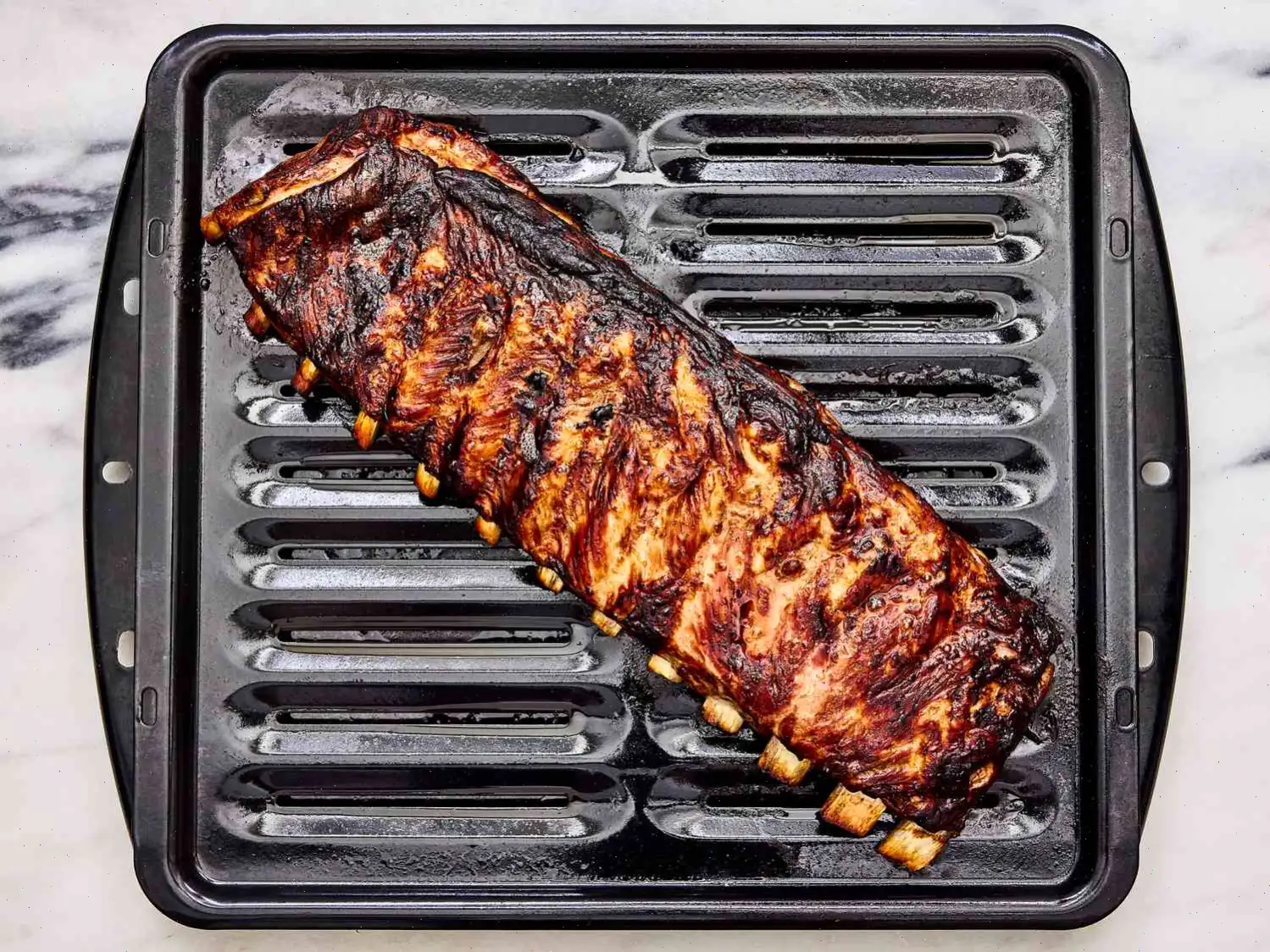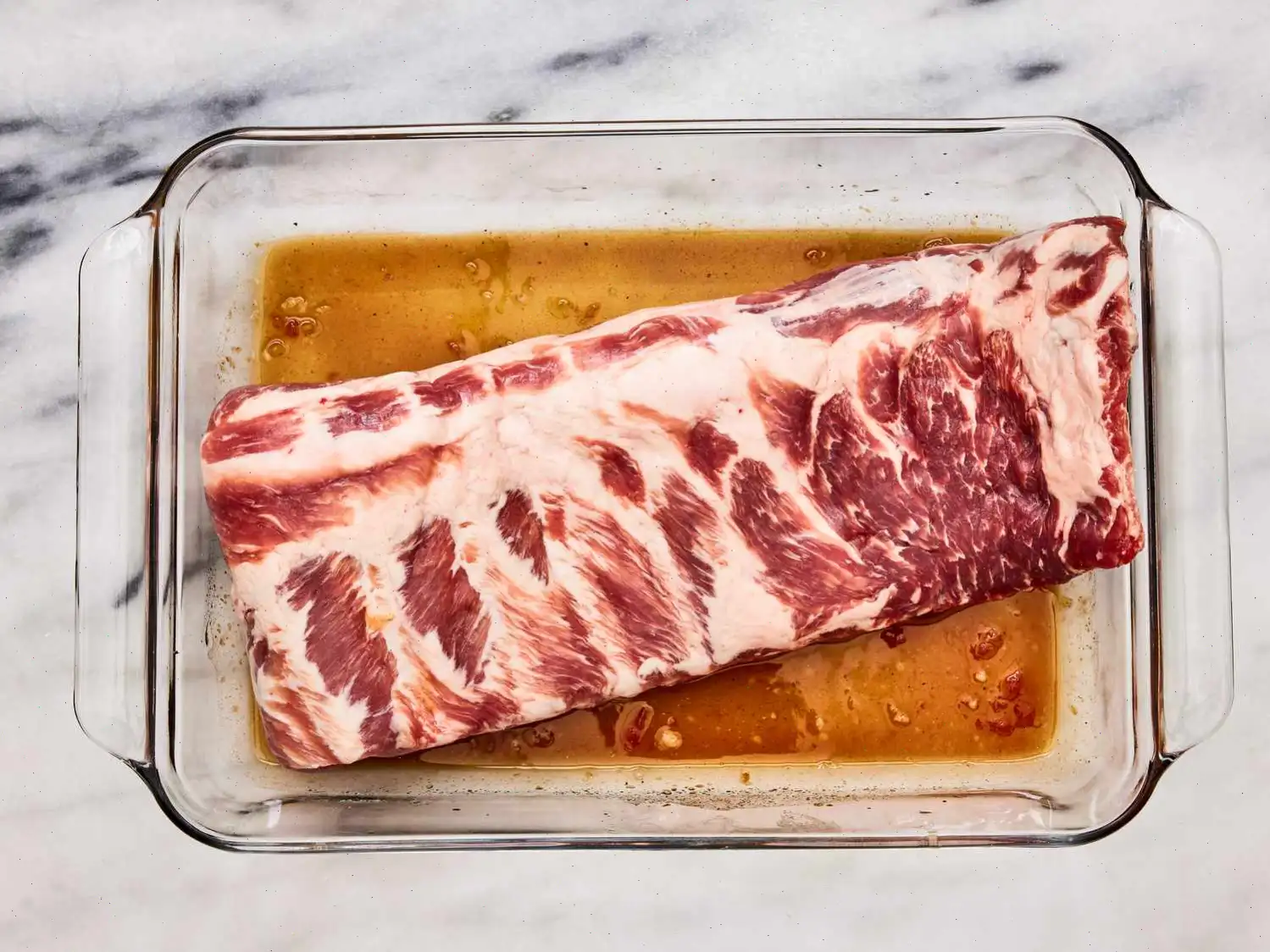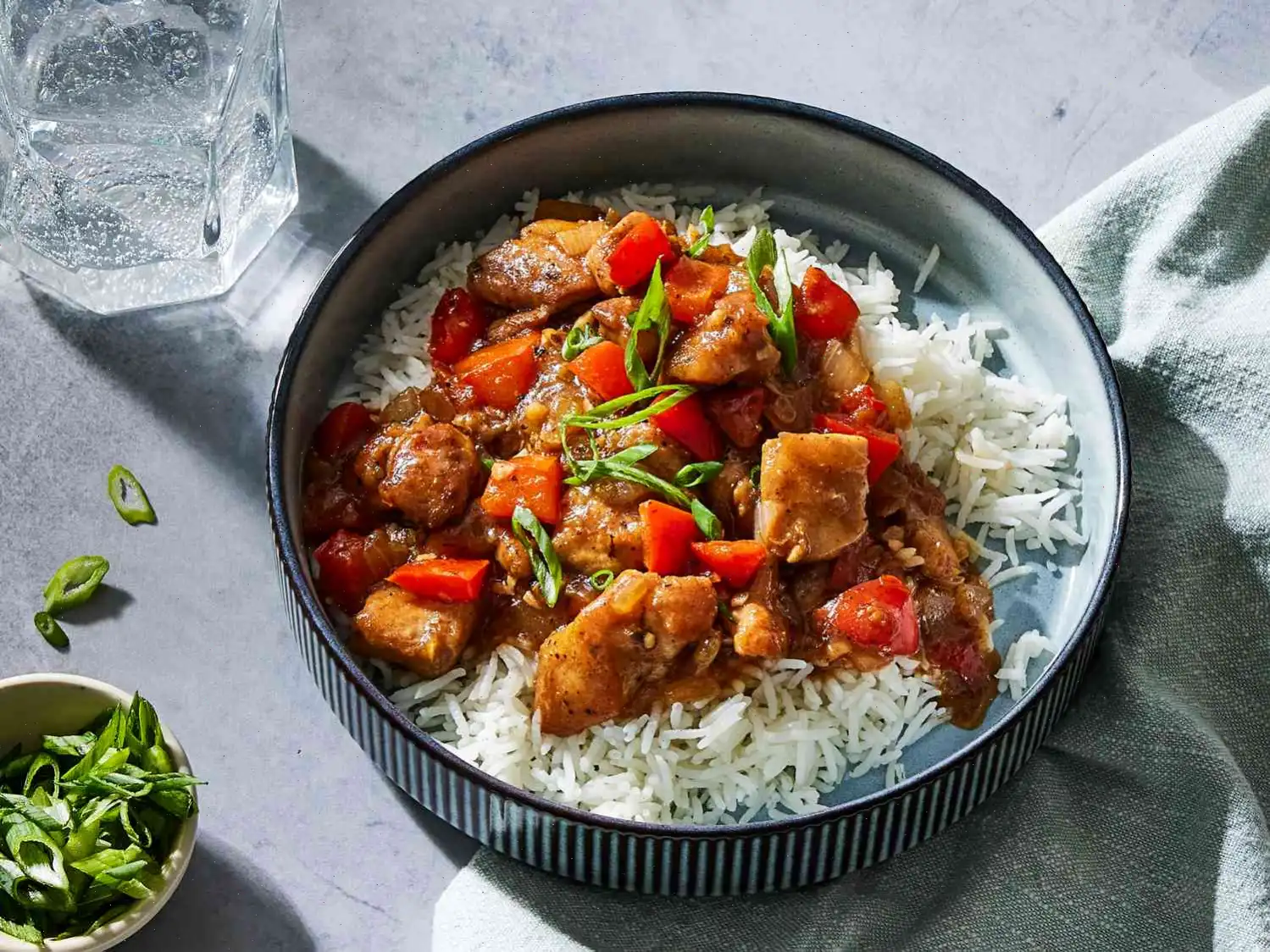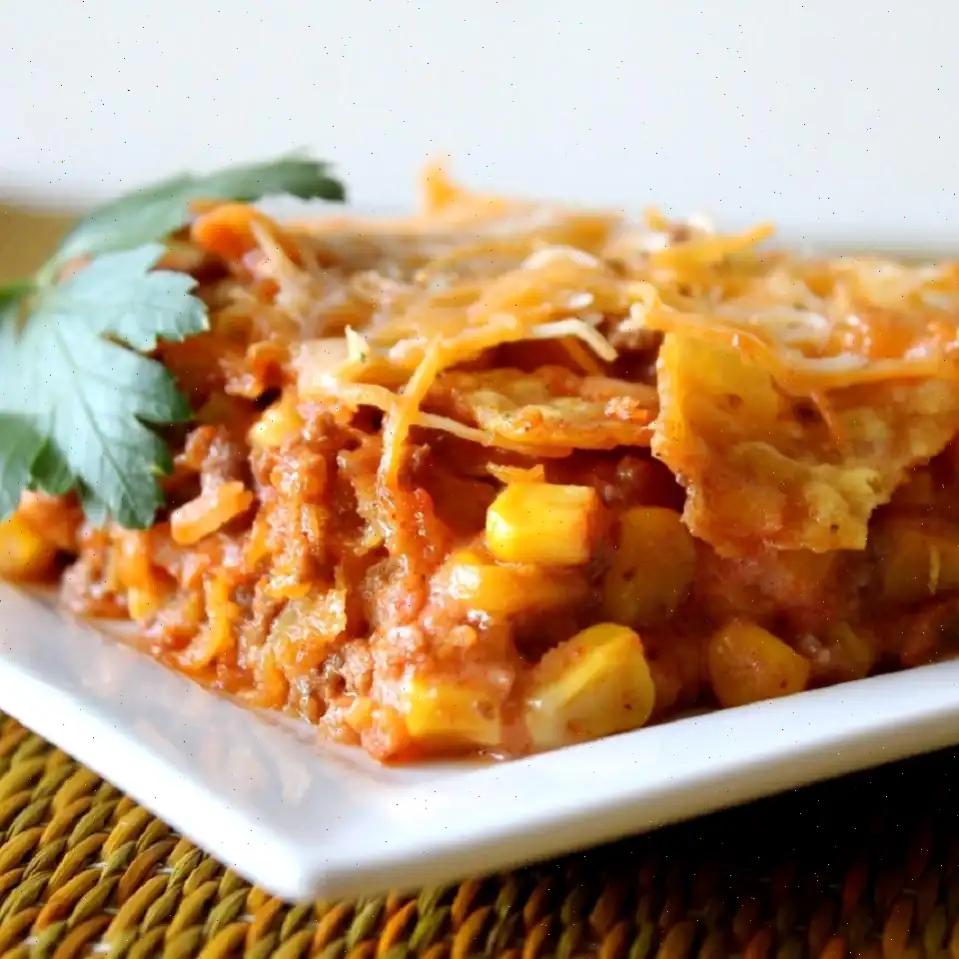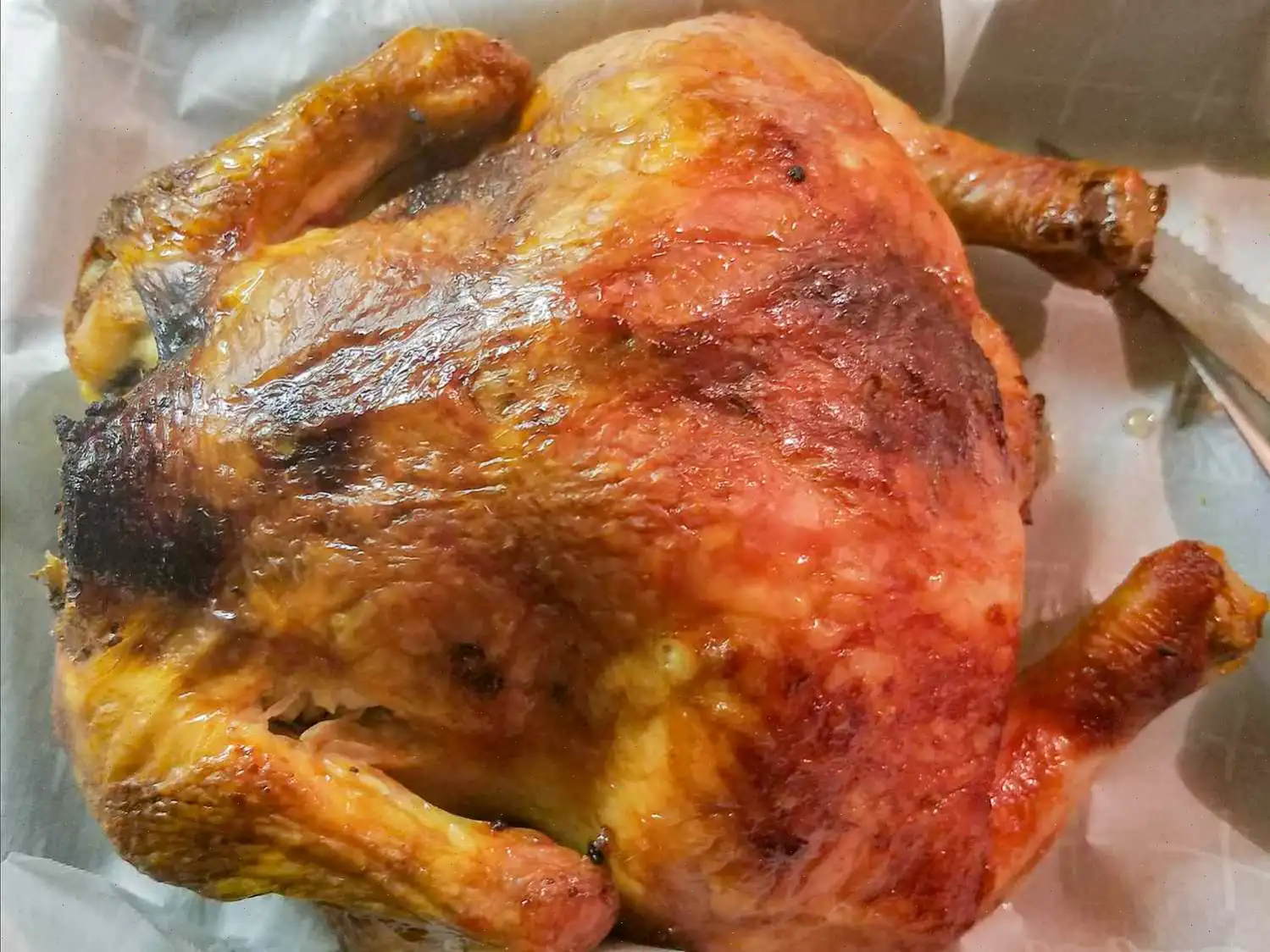
Chinese Spareribs Recipe
Ingredients
- 3 tablespoons hoisin sauce
- 1 tablespoon ketchup
- 1 tablespoon honey
- 1 tablespoon soy sauce
- 1 tablespoon sake (or Chinese rice wine)
- 1 teaspoon rice vinegar
- 1 teaspoon lemon juice
- 1 teaspoon grated fresh ginger
- teaspoon grated fresh garlic
- teaspoon Chinese five-spice powder
- 1 pound pork spareribs
Directions
Step 1: Gather all the ingredients.
Step 2: In a shallow glass dish, combine hoisin sauce, ketchup, honey, soy sauce, sake, rice vinegar, lemon juice, grated ginger, garlic, and Chinese five-spice powder. Mix well.
Step 3: Add the ribs to the dish and turn them to coat with the marinade. Cover the dish and place it in the refrigerator. Let the ribs marinate for at least 2 hours, or up to overnight for better flavor.
Step 4: Preheat the oven to 325F (165C). Prepare a broiler tray by adding enough water to cover the bottom.
Step 5: Place a grate or a rack over the tray and arrange the marinated ribs on the grate.
Step 6: Cook the ribs in the preheated oven for 40 minutes on the center rack. Every 10 minutes, turn the ribs and brush them with the remaining marinade.
Step 7: During the last 10 minutes of cooking, allow the marinade to cook onto the ribs, forming a glaze. For extra crispiness, finish under the broiler if desired.
Step 8: Discard any remaining marinade before serving.
Nutrition Facts (per serving)
| Calories | 31g Fat | 23g Carbs | 30g Protein |
|---|---|---|---|
| 503 | 31g (40%) | 23g (8%) | 30g (61%) |
| * Percent Daily Values are based on a 2,000-calorie diet. Your daily values may be higher or lower depending on your calorie needs. | |||
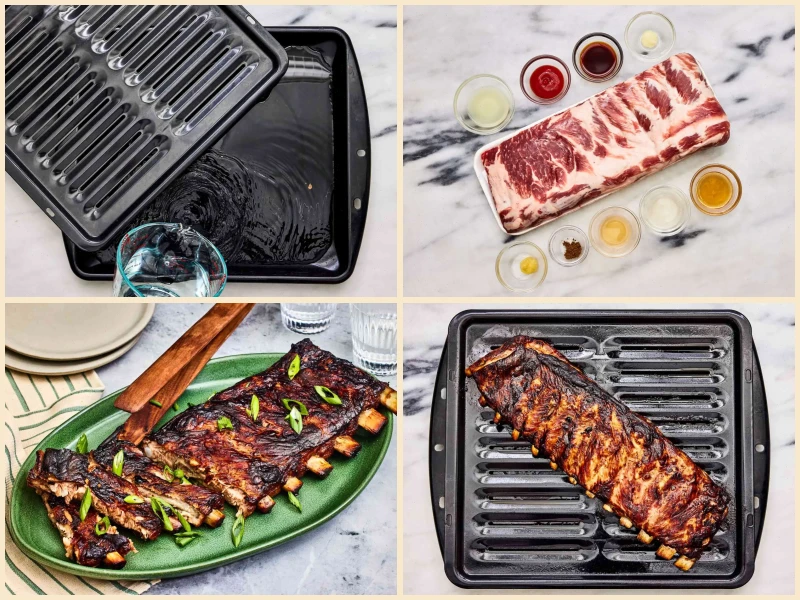
Origin and History
Chinese spareribs have a long and flavorful history, with origins deeply rooted in the culinary traditions of China. The dish is part of a broader category of Chinese pork-based recipes, where spareribs are marinated, slow-cooked, and glazed with a tangy, sweet sauce. While specific records of when the dish was first created are hard to trace, its distinct flavor profile of soy sauce, hoisin sauce, and spices like five-spice powder has been a hallmark of Chinese cuisine for centuries. The use of pork ribs as a main ingredient was influenced by the abundance of pork in China, which remains the most commonly consumed meat in the country.
Regional Variations
Chinese spareribs are enjoyed across various regions of China, each with slight variations in preparation. For example, in Southern China, particularly in Cantonese cuisine, spareribs are often marinated in a sweeter sauce, using honey, hoisin, and sometimes even red bean paste, giving the dish a smooth, sweet finish. In contrast, Northern China tends to emphasize stronger, savory flavors with the use of soy sauce and vinegar to balance the sweetness. The dish is also popular in Chinese-American cuisine, where it is typically prepared in a style that is both sticky and slightly crispy, commonly served as part of a takeout meal.
How Chinese Spareribs Stand Apart
Though there are several dishes that feature ribs across global cuisines, Chinese spareribs stand out due to their unique marinade. The combination of hoisin sauce, soy sauce, rice vinegar, and Chinese five-spice powder creates a perfect balance of sweet, salty, and umami flavors that are deeply infused into the meat. Unlike traditional American barbecue ribs, which are often slathered with a thick barbecue sauce and grilled or smoked, Chinese spareribs are typically marinated for hours or overnight and baked or roasted to tender perfection. The glaze that forms during cooking adds a layer of sticky sweetness that is a signature of Chinese-style cooking.
Where Are Chinese Spareribs Typically Served?
Chinese spareribs are a popular dish in Chinese restaurants worldwide, often featured as a highlight of a dim sum menu or as a main course in larger meals. In China, they are commonly served at family gatherings, banquets, and festive occasions. The dish pairs well with steamed rice, sauted vegetables, or stir-fried noodles. In Western countries, Chinese spareribs are frequently found in Chinese-American restaurants, particularly as part of take-out meals. They are often paired with sides like fried rice, egg rolls, or fortune cookies to create a full meal.
Interesting Facts
- Chinese spareribs are often cooked to achieve a caramelized glaze, which is a key feature of the dish. The sugars in the marinade, particularly honey, help create this glossy, sticky finish.
- Many recipes for Chinese spareribs call for marinating the ribs for several hours or overnight. This helps the meat absorb the rich flavors of the marinade, making it extra tender and flavorful.
- While the dish is a staple in Chinese-American cuisine, its preparation can be quite varied. Some recipes even call for grilling the ribs for a charred, smoky flavor.
- In some regions, a red food coloring is added to the marinade to give the ribs a vibrant, restaurant-style red hue. This is more common in Western adaptations of the dish.
FAQ about Chinese Spareribs Recipe
Comments
Ryan Evans
10/16/2022 06:00:47 PM
Incredible! I marinated the baby back ribs for 18 hours in a freezer bag and cooked them in the crock pot for 6 hours on low. I doubled the marinade recipe and added 1 tsp of sriracha, 1 tsp of toasted sesame oil, 1 tsp of liquid smoke, 1 tsp of fish sauce, and 1 chopped shallot. I poured the marinade into the crock pot with the ribs and later used it as a sauce over the ribs and jasmine rice for serving. The ribs were unbelievably tender and flavorful, and the marinade/sauce was truly exceptional.
Emma Perez
12/06/2023 12:18:35 PM
Review: Amazing! This recipe closely resembles the flavors of Chinese restaurant ribs. I adjusted the measurements to make a larger batch for 5 lbs. of ribs. Since I didn't have sake, I substituted white wine and added 1 tsp. of powdered ginger. I parboiled the ribs for about 20 minutes before marinating them in some of the sauce all day and grilling them with occasional basting. To further tenderize, I transferred them to a slow cooker with the remaining marinade for a few hours. For a more authentic look, I incorporated a few drops of red food coloring into the marinade. Absolutely delicious!
Heather Torres
06/11/2023 05:26:46 PM
I followed most of the reviewers' recommendations, including adding a hint of fish sauce, ginger paste, and lots of garlic. I cooked the marinade and used it on the ribs before broiling them for 5 minutes... AMAZING. I paired it with pork fried rice and sautéed snow peas. A perfect Saturday night "take out" meal at home.
Michael Hill
10/28/2023 11:17:01 AM
I really enjoyed the flavor of this dish. However, I did make some modifications. I added a touch of red and orange food coloring to achieve a more traditional Chinese restaurant-style appearance, and I found that cooking it for 40 minutes wasn't quite sufficient as it remained undercooked on the inside. After slicing it, I baked it for an extra 40 minutes, periodically basting and turning it, resulting in a perfect medium-rare (145°F) finish, which was just right for my taste. In the future, I may increase the amount of honey and add a bit more five spice for added flavor.
Donna Baker
03/23/2023 06:57:53 AM
Outstanding flavors in this dish! The combination of sweet hoisin, ketchup, and honey, along with the tanginess of rice vinegar and lemon, creates a perfect harmony. I increased the amount of sauce threefold and cooked the ribs in a slow cooker, resulting in incredibly tender and flavorful ribs. Huge thanks for sharing this fantastic recipe!
Samantha Williams
03/02/2023 03:50:25 PM
Exceptional flavor, I have prepared this dish numerous times. The only slight issue is that there are never any leftovers, regardless of the quantity I prepare.
Margaret Wilson
08/21/2023 07:01:46 AM
Simple and delicious.
Edward Wright
05/06/2025 01:27:48 PM
This recipe is excellent! I highly recommend basting the dish throughout the cooking process. I followed step 2 by placing it in the broiler. The recipe didn't specify this, so initially, I baked it at 325 degrees as directed. However, to achieve the perfect glaze at the end, I switched to broiling and rotated the dish regularly.
Aaron Smith
01/26/2023 08:43:28 PM
The ribs were delicious. Next time, I'll definitely try the BBQ sauce with a touch of spicy heat.
Scott Carter
09/17/2024 09:49:54 AM
I made these dishes last night, along with Thai Brussels sprouts. It was a bit of a fusion meal, but both were absolutely delicious!





